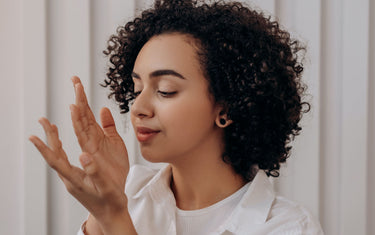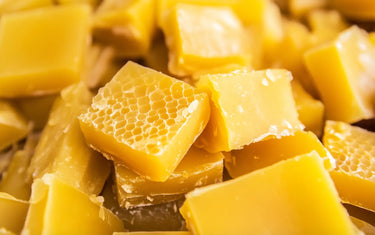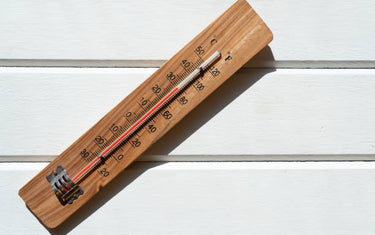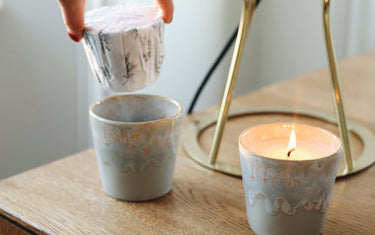4 min read / 27 January 2023 / Laura Garvin Gomez
Inhalation of Essential Oils - The Aromatherapy Guide
Unlock the therapeutic power of essential oils through inhalation with our comprehensive guide to aromatherapy.
Share this post

From fighting off infections and combating colds to calming your nerves and helping you to de-stress, essential oils can go a long way to making your mind and body feel better.
Through aromatherapy, you can safely take in the healthy properties contained in essential oils while scenting your home with an array of wonderful aromas. Here we explain more about aromatherapy and the benefits of inhaling essential oils.
What is aromatherapy?Aromatherapy is a holistic healing treatment that uses plants and their extracts to promote good health and well-being. The treatment revolves around the use of essential oils to improve bodily health, mind and spirit. Physical and mental health can be boosted through the use of aromatherapy, either through inhalation or topical application to the body. Aromatherapy is one of the most ancient healing arts, tracing as far back as 4500 B.C. when Egyptian civilisations used aromatic substances in medicines. |
How can you breathe in essential oils?
When you inhale essential oils, it very quickly enters the bloodstream to benefit your body and mind. There are a number of ways you can inhale essential oils, such as:
-
Use a diffuser
Diffusers come in many forms, be it an ultrasonic diffuser that uses a combination of water and electronic frequencies. Heat diffusers use heat elements to enable the oil to evaporate into the air.
-
In the bath
A nice relaxing warm bath mixed with essential oils promotes both inhalation and topical absorption. Once you settle into the tub, you will naturally inhale the oils through the steam emitted from the warm water.
-
Steaming water
Add some essential oils to a bowl of hot steaming water before covering your head with a towel and placing your face over the steam.
-
Through a tissue or cotton ball
Simply take your favourite essential oil and add a few drops to a tissue or cotton ball. Then, place it nearby on a desk, table or bedside table and let it evaporate for a while. You can also set it underneath your pillow for the night to emit as you sleep.
-
Spray into the air
Using a DIY essential oil room spray (mixed with distilled water in a spray bottle), simply spray the oil around your home and breathe in the oil as it settles around you in the room.
-
Aromatherapy accessories
There are lots of aromatherapy accessories you can buy that are made with absorbent materials like lava stone, such as bracelets, necklaces and keychains, so you can add essential oils and take light sniffs to inhale them throughout the day.

Is the inhalation of essential oils safe?
It is perfectly safe to inhale essential oils and is arguably the safest method of administration. However, you still need to take care when inhaling essential oils, even when diffusing.
When inhaling using an essential oil you should make sure to:
- Always follow the dilution guidelines provided
- Ensure there is good ventilation in the room
- Diffuse for a maximum of 30-60 minutes and take regular breaks
- Be aware that diffusion may have a negative health impact on your pet (especially cats)
Not all essential oils are suitable for inhalation. You must take care not to administer a dose that is too high to avoid toxicity or poisoning.
Try Lavender Essential Oil for good night’s rest
Many people use lavender essential oil for its calming abilities and inhalation is a great way to settle your nerves and reduce feelings of anxiety. If you are having trouble sleeping, lavender can help you drift off – using a diffuser for a short while before bed to aerate the bedroom can relax your mind and body for a restful night’s sleep.
Fight off colds and coughs with Tea Tree Essential Oil
A quick and easy way to enjoy the benefits of tea tree essential oil is by using a diffuser, adding it to a warm bath or mixing it into a candle recipe. It is said to do wonders for the respiratory system, relieving congestion and fighting infections, so it could make all the difference during the winter months with colds and cough bugs floating around.
Peppermint Essential Oil may aid the recovery process
Some small clinical trialshave been carried out and found that inhaling peppermint essential oil vapours helped people recovering from heart surgery. The inhalation of peppermint oil could also help to manage infections due to its antibacterial properties, as well as combating the flu to reduce some of the symptoms.
Give yourself a vitamin C boost with Lemon Essential Oil
Lemon essential oil can be a useful tool to give you a boost if you are feeling tired, depressed or experiencing changing moods. It’s an effervescent oil that can quickly inject brightness and life, and its high vitamin C levels can help to ward off viruses. Add it to a candle recipe or burn it with a diffuser to inhale the oil and enjoy its incredible benefits.
Clary Sage could help ease stress and anxiety
When clary sage essential oil is used in aromatherapy, it can improve your overall sense of well-being by alleviating stress and anxiety. The oil has a clean, refreshing scent and is known to improve skin conditions and fight infections. Add a few drops to a warm bath, enjoy the fragrance with an oil burner or make it the main ingredient in a candle recipe.

Using essential oils should be fun and easy, and aromatherapy inhalation of essential oils ticks both of those boxes. However, as our guide advises, always take good care, follow the application guidelines provided with each oil, and use our other tips to remain safe. Apart from that, there are no set rules on how to enjoy your essential oils, and the most important thing is that you feel they are giving you the benefits you need.









